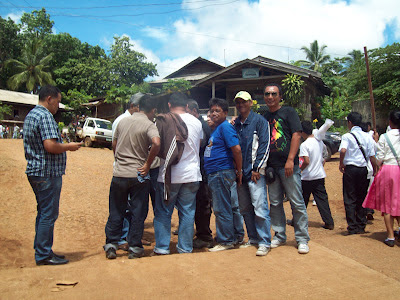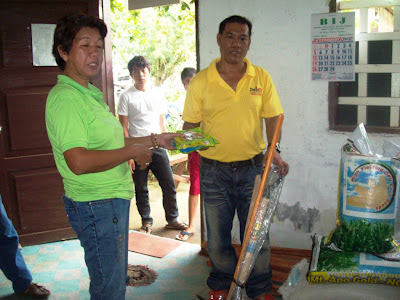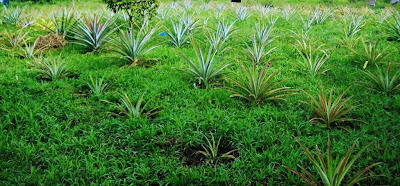The Department of Agrarian Reform (DAR) is confident that Notices of Coverage can be issued for all lands under the Comprehensive Agrarian Reform Program Extension with Reforms (CARPER) before the law expires in year 2014. In fact, DAR will be able to issue Notices of Coverage for all Phase 1 – 3A landholdings before the end of 2012. It will also be able to issue Notices of Coverage for all Phase 3B lands in the first quarter of 2013[1], subject to the requirements of RA 9700.
This move, according to Agrarian Reform Secretary Virgilio de los Reyes, will ensure that all landholdings covered by CARP will be distributed to farmer-beneficiaries before the term of President Benigno Simeon Aquino ends in 2016.
De los Reyes said that from February to May 2012, days were set for the mass processing of claims folders in all provinces with significant land acquisition and distribution balance[2] (or LAD balance) especially the 21 provinces where more than 60% of the LAD balance is located.
These “claim folder days” enabled the DAR management to analyze individual landholdings targeted for acquisition in order to track its progress and address problems. This will enable the DAR to institute global solutions to problems delaying the LAD process. This mass processing of all claim folders had never been done before. Data from these claim folder processing is being processed and will be utilized to craft specific measures to address specific types of problems.
The mass processing of claim folders will enable DAR to determine which landholdings have not yet been issued Notices of Coverage (NOCs), which have been issued defective NOCs, which have been issued NOCs but it is unclear whether it had been properly received. For these landholdings, DAR will issue or reissue Notices of Coverage.
Delos Reyes again stressed that agrarian reform under the Aquino Administration is proceeding apace despite the huge challenges facing the program.
During President Aquino’s first two years, DAR managed to acquire and distribute 219,069 hectares of land throughout the country.
Though this is not exemplary, this is by no means the lowest accomplishment in the history of the Comprehensive Agrarian Reform Program (CARP).
The lowest recorded was 59,495 hectares of land distributed in 2009 because of the uncertainties brought about by the transition the new law extending funding for the agrarian reform program (RA 9700 or CARPER). The second lowest was 97,795 hectares recorded in 2003.
Last year alone, the Department of Agrarian Reform (DAR) distributed 111,889 hectares of land nationwide, which is slightly higher than the 107,180 hectares distributed in 2010.
DAR has completed the acquisition of 18,414 landholdings with a total area of 120,286 hectares for a gross accomplishment rate of 60%. Of this area, 8,397 hectares are exclusions from the same landholding and retention areas of landowners.
Thus, 111,889 hectares were actually distributed to 63,755 agrarian reform beneficiaries last year.
Delos Reyes explained that the remaining Land Acquisition and Distribution (LAD) Balance of 961,974 hectares nationwide will be covered under the guidelines set by CARPer.
Phase 3B lands (5-10 hectares) constitute 187,959 hectares of the LAD balance. This can only be covered from July 2013 to June 2014.
Phase 3A lands (10-24 hectares), which can only be covered from July 2012 to June 2013, totals 217,639 hectares. But, only Phase 3A lands in excess of 10 hectares can be covered during this period. This means that 163,660 hectares of Phase 3A lands can only be covered from July 2013 to June 2014. Thus 351,619 hectares of the LAD balance (37%) can only be covered in the last year (July 1, 2013 to June 30, 2014) of CARPER.
This leaves only 610,355 hectares of the LAD balance that can be covered from now until June 2013. Of this total hectarage, 13,553 hectares are for reconstitution, 30,984 hectares are untitled private agricultural lands and 179,826 hectares are problematic landholdings (with cases, with defective titles or technical descriptions, etc.)
Delos Reyes said DAR is right on schedule in land acquisition and distribution despite the fact that the remaining lands to be distributed are the more contentious ones and requires a longer and more tedious process to acquire and distribute.
It should be noted that the large portion of the DAR’s accomplishments in previous administrations are acquisitions that are “easy”: government-owned lands, voluntary land transfers, and voluntary offer to sell. The remaining balance is by no means easy to distribute:
- Around 93.58% of the LAD balance (900,188 hectares) are private agricultural land;
- Almost 85% of the LAD Balance (816,491 hectares) are LBP-compensable (that is, government will pay the landowner just compensation);
- About 62% of the LAD balance (596,036 hectares) will be covered through compulsory acquisition (CA).
Therein lies the challenge. Government-owned lands are easy to distribute precisely because the government owns the land and in a number of cases just recognizes the possession of the actual tiller of the land.
Voluntary modes of acquisition and distribution are easier precisely because the landowner offers his land for distribution. There are two modes: voluntary land transfer (VLT) and voluntary offer to sell (VOS). The difference between the two is that in the case of VLT, government does not pay for the land because this is a direct payment scheme (the agrarian reform beneficiary pays amortization directly to the landowner). In the case of VOS, government pays for the land, distributes it to beneficiaries and the beneficiaries pay amortization to the Land Bank of the Philippines.
In contrast, coverage through Compulsory Acquisition is just that—compulsory. Government (DAR) acquires the land whether the owner wants to or not and distributes these to farmer-beneficiaries. The documentation in these cases is more tedious and the process takes longer. The flowchart at the end of this paper show the entire process of compulsory acquisition and compares this with other modes of acquisition and distribution.
And a lot can happen to slow down the process:
- Titles can become missing. Technical descriptions in titles may be erroneous. Or the landholding may be an untitled property. Or the landholding might be projected as being timberland. (The land management system and the titling system in the country is not of the best quality although the current Land Registration Authority and the DENR are trying to remedy this through digitization and computerization).
- The landowner might have been able to sell or transfer the landholding without the necessary DAR clearance. Or the landowner on record might have died.
- The landowner might file a Protest against Coverage or a Petition for Exemption/Exclusion.
- During beneficiary identification, petitions for inclusion or exclusion may be filed.
The above list enumerates just the most common factors that slow down the land acquisition and distribution.
It should be noted also that additional provisions in the RA 9700 or CARPER stretched the acquisition process to 12 – 15 months. The process of farmer beneficiary (FB) identification alone takes 5 to 6 months to complete as it requires posting, attestation of landowner, revalidation of list of FB materlist, among others.
The present DAR Administration has been able to put up the systems that will speed up the land distribution process, but only after thorough analysis of what needs to be improved.
To speed up the process, new rules for land acquisition and distribution was drafted and issued on October 2011. The Revised Rules and Procedures Governing the Acquisition and Distribution of Private Agricultural Lands (AO 7 Series of 2011) simplified the LAD process and shortens the process to 182 working days (about 9 months).
Additional improvements in making the LAD process faster and more efficient were put in place in the last half of 2011. These include (a) monitoring the progress of acquisition on a per landholding basis and (b) the institution of time standards and cost parameter per LAD activity. In this way, DAR’s field offices and the Central Office Field Operations Office can track deviations, immediately identify problems and put in place remedial measures. Additional survey equipment and survey software compatible with those used by the DENR were procured to speed up surveys and its approval by the DENR. Negros Occidental alone now has 20 complete survey stations with corresponding computer hardware and software.
In the two provinces with the highest land acquisition and distribution balances, Negros Occidental and Camarines Sur, the provincial office was split into two operational units. The staff of Negros Occidental has been augmented with additional personnel. Vehicles and equipment have been, or are being, procured.
Global solutions to technical and administrative problems are being explored as well to address technical and other issues that delay the acquisition process. For this, the DAR is working closely with its partner agencies, the Land Registration Authority (LRA) and the Department of Environment and Natural Resources (DENR). A Joint Memorandum Circular of the DAR and LRA signed last December 2011 would require the annotation of the Notice of Coverage on titles of CARP-covered lands to prevent illegal transfers meant to circumvent CARP coverage. Agreements in principle will permit DAR to request the mass processing of documents required from the LRA and the DENR. For example, the DAR has completed the list of about 10,000 landholdings targeted for coverage in Negros Occidental for which it requested Certified True Copies of titles from the LRA. Likewise, DAR has completed a list of landholdings from North Cotabato, Sultan Kudarat and Lanao Norte for which it will request LMS certifications from the DENR. (LMS is the Land Management Sector of the DENR).
Phase 1:Large private agricultural landholdings above 50 hectares as well as rice and corn lands under PD 27, all idle and abandoned lands, and private lands voluntarily offered by owners for agrarian reform (VOS and VLT).
Phase 2A:Private lands 24 hectares up to 50 hectares which have been subjected to Notices of Coverage on or before December 10, 2008, land of government financial institutions (GFI), landed estates, settlements and other government-owned lands. With Phase 1, this is scheduled for acquisition and distribution until June 2012.
(Phase 1 – 2A lands are currently being covered for acquisition and distribution)
Phase 2B: All remaining private lands in excess of 24 hectare up to 50 hectares.
Phase 3A: Smaller landholdings above 10 hectares up to 24 hectares in so far as the excess hectarage above 10 hectares are concerned.
(Phase 2B and Phase 3A lands are due for acquisition on July 1, 2012 up to June 30, 2013.)
Phase 3B: Small private agricultural lands that are above 5 hectares up to 10 hectares.
(Phase 3B lands are scheduled for distribution on July 2013 to June 2014.)
LAD balance refers to CARPable lands that have yet to be acquired and distributed.
(Reposted from www.dar.gov.ph)

















































